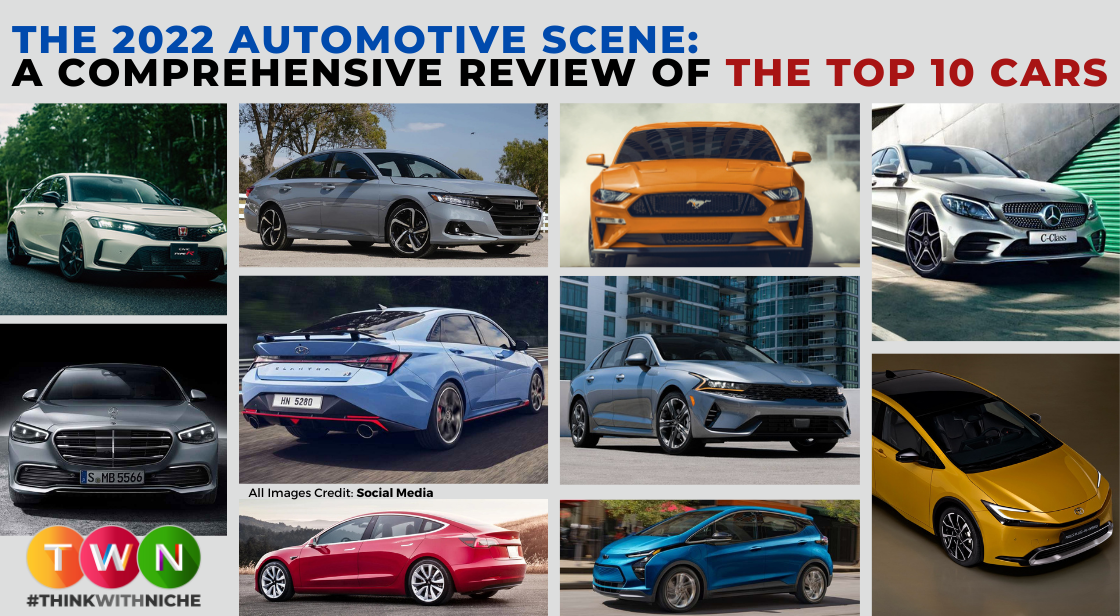The 2022 Automotive Scene: A Comprehensive Review of the Top 10 Cars

Blog Post
In 2022, a number of new cars and SUVs were introduced, and no market category was lacking in activity. While SUVs remained the most preferred body type among consumers of automobiles, the midsize sedan market experienced a welcome comeback thanks to models like the Volkswagen Virtus and Hyundai Elantra. New Kia K5 and Honda Accord models adorned the entry-level categories, and the luxury automobile industry expanded across all price ranges.
As the year comes to a close, we take a look at the top 10 car reviews that have received the most attention. The fact that all of the top 10 reviews are for cars from various segments shouldn't come as a surprise. We'll give you A Comprehensive Review of the Top 10 Cars in this blog post.
We back to the year that was 2022 as the year is closed. When it came time for you to buy a new car, we worked hard to make sure you had all the information you required, which required us to drive quite a few vehicles. As we draw the curtains on this year, we'll look back at the top 10 cars we tested in 2022. A few recognizable brands made a comeback in 2022, elevating their reputations to even greater heights, while other carmakers unveiled models tailored specifically for India to increase their market share.
The global auto market sees the introduction of new vehicles every year with the aim of upending it with cutting-edge products. We have covered some of the best cars that dominated the market in 2022 as well. While other carmakers unveiled models to further cement their dominance in their respective niches, a few recognizable brands returned in all-new guises, elevating their respective monikers to even greater heights. But the selection criteria for our top 10 car reviews of 2022 were straightforward: we looked for new products that not only advanced modernization and innovation in the relevant fields, but also provided significantly greater novelty value for consumers with enhanced tastes in high-quality products. The top 10 automobile reviews of 2022 are shown here.
A Comprehensive Review Of The Top 10 Cars
1. Civic Honda 2022 -Small
The Honda Civic continues to rule the small-car industry, despite the fact that small sedans are losing market share to crossovers. Despite the difficulties caused by Covid-19 and the fact that the basic car was already half a decade old, Honda sold 260,000 of them in 2020. In 2022, the Civic undergo a complete redesign for its eleventh generation, giving up the peculiar boy-racer looks of earlier versions in favor of a sleek and mature shape and a more convenient, fashionable interior.
For the first time since the mid-2000s, the Civic is once again the entry-level model in Honda's lineup because the Fit has been discontinued. Older Civic drivers would be startled to hear that the car is now around the same size as a mid-1990s Accord at 184 inches long. They'll be pleased to learn that it has a roomier inside than that old midsize and still upholds all of the Civic's traditional virtues. It's enjoyable to drive, comfortable inside, and filled with features even in base model form.
Honda makes a lot of effort to hook those consumers on a lifetime of Hondas because it is aware that the Civic is, as always, popular with first-time purchasers. The business is also aware of how superior the Civic's primary competitors, namely the Hyundai Elantra and Mazda3, have developed over time.
2. Hyundai Elantra- Small
The Hyundai Elantra grew from a bargain-basement beater to a highly sought-after compact sedan, much like a caterpillar becoming a butterfly. The Elantra still ranks highly on the scale based, but it now provides top-notch active safety and tech features, a variety of fuel-efficient hybrid and potent performance powertrain choices, and the kind of interior space traditionally only found in midsize cars. It encases everything in a lean, distinctive outfit.
In addition to growing 2.2 inches longer and 1 inch wider and losing its hatchback option, the Elantra underwent a thorough redesign last year. It transformed from an afterthought to one of the loveliest vehicles in the compact class in a single bound, and it competes fiercely for the title of best in class in many ways with the newly released Mazda3 and the revised Honda Civic this year. The Kia Forte, Toyota Corolla, and Volkswagen Jetta are further competitors.
The Elantra Hybrid, which comes in two trims and offers up to 54 mpg combined, was one of the most fuel-efficient gas-powered vehicles on the market last year. The Hyundai Elantra N, a specialized performance sedan that builds on the Veloster N hatchback, is the big news this year. For vehicles like the VW Jetta GLI and Subaru WRX, the N is a dangerous opponent because of its track-bred handling and up to 286 horsepower.
3. Honda Accord -Midsize
The Honda Accord may be nearing the end of its current generation, but it continues to reign supreme among midsize family cars. It continues to dazzle as a driver-focused vehicle with assured handling that also happens to have a cozy, practical cabin and a broad list of standard features. For individuals who don't desire a big, bulky crossover, everything is contained in an attractive and functional design.
In 2022, a new Accord is scheduled to be released. Honda expands on its mid-cycle revamp from the previous year, which altered the front end with a larger chrome grille and technological advancements. The lineup of the Accord continues to be made up of a total of 10 trims, distributed across three powertrain choices. Along with the base 192-horsepower 1.5-liter four-cylinder and continuously variable automatic gearbox (CVT), the midrange 212-horsepower hybrid, and the top-spec 252-horsepower 2.0-liter four-cylinder with 10-speed automatic, are still available.
The Accord competes against segment heavyweights like the Toyota Camry, Nissan Altima, Hyundai Sonata, Kia K5, Volkswagen Passat, Chevrolet Malibu, and Subaru Legacy, but is frequently rated best in class for value and driving characteristics by both critics and fans. This is despite facing more fierce competition than ever, particularly from Korean entries, which have engineering and performance influenced by Germany and surpass Japanese quality and reliability.
4. Kia K5 -Midsize
After the model year 2020, Kia's family-oriented Optima sedan was consigned to the big discontinued model graveyard in the sky, and the K5 took its place. The K5, which was launched last year, is a mix of the greatest elements of the brand's past sedan lineup, including the flashy Stinger. That enormous sporty sedan never received the recognition it deserved and may be discontinued to make room for more SUVs (which is not surprising considering the public's preference for bigger cars). The K5, especially in GT form, retains the sassy spirit of the Stinger.
The base LX model of the K5 costs $24,885, which is $1,270 less than a brand-new Honda Accord and almost $1,500 less than a Toyota Camry. From the LX, you can upgrade to the LXS for $25,455, the GT-Line for $26,355, the luxury-focused EX for $28,955, and the GT for $31,455. The base trim and the highest trim are only $7,000 apart, so upgrading is a very reasonable alternative. Other rivals include the Nissan Altima, Subaru Legacy, and Hyundai's Sonata, which, underneath the skin, is closely related to the K5.
For 2022, the Korean manufacturer introduces a few new features, like a surround-view monitor that is standard on EX and GT versions and optional on other trims. This year's K5 features a new Kia emblem, power-folding mirrors, front park distance warning, and rear windows that automatically rise and lower with the luxury package. Although the LXS and GT-Line variants are available with all-wheel drive, all models come standard with front-wheel drive.
5. Toyota Prius -Hybrid
Visit the airport, and you'll find a long line of Toyota Priuses waiting for you. In terms of popularity with rideshare drivers, it's true that some other hybrids, such as the Hyundai Ioniq and Toyota's own RAV4 and Venza, are coming up, but the Prius is still the top dog in the Uber and Lyft market. Why? Because the Prius was designed to get the best possible gas mileage, be extremely practical, and be incredibly reliable. It succeeds at providing cheap transportation for people and comes with a tonne of functions, but it falls short in a lot of other respects.
Except for the inclusion of optional all-wheel drive (AWD) in 2019, the current Prius hasn't undergone many alterations since it was launched in 2016. It has received a continuous diet of new standard amenities, including heated front seats and a steering wheel for 2022, but it still feels dated inside and was clearly made on a budget. Since it was converted to a hatchback in 2004, the Prius' basic design, interior, and aesthetic haven't actually altered all that much. Despite the '22's many contemporary comforts, the interior still has a little of the 2004 vibe. The Prius Prime, a plug-in hybrid vehicle also made by Toyota, is reviewed separately.
The fact that there is fierce competition, despite Prius' continued excellence, is an issue. The 2017 Hyundai Ioniq follows the same format but has a finer appearance, more conventional controls, and higher gas mileage. The Hyundai Elantra Hybrid has superior handling, is more affordable, and is almost as effective. The Honda Insight is in its penultimate year before being replaced by a new Civic Hybrid, but it's also easier to drive and nearly as economical. Hybrid SUVs like the Venza, Niro, and Tucson suffer minor mpg losses but provide significantly more space and luxury.
6. Tesla Model 3- Electric
Despite being five years old, the Tesla Model 3 is still in many ways the best electric vehicle on the market. The Tesla Supercharger network continues to be a significant advantage in the real world, and all three variants offer greater range and higher performance than their recently introduced rivals. This unusual vehicle is not for everyone, and it is no longer as inexpensive (this year's prices range from $2,000 for the base model to $7,000 for the Long Range), but the 3 still provides good value.
Tesla doesn't release cars according to model year, but the base-model 3 will become Rear-Wheel Drive (RWD) in 2022 and get a new battery pack. The previous name of the model was Standard Range Plus. Less cobalt is used than in the previous chemistry. Although it uses less energy than the other versions (which can only be charged to 90% to prevent battery deterioration), it extends the range by 9 miles. Approximately 5 miles are added by the Model 3 Long Range, but aside from that, the 3 is largely unchanged from 2021.
Although it has always been a luxury vehicle, the 3 really stood out when it was first launched in 2017 as the longest-range "affordable" EV. Since then, numerous further rivals have arisen, including the Polestar 2 and Jaguar I-Pace. The BMW i4 and Kia EV6 will pose even greater competition in 2022. Although the I-Pace and EV6 are classified as crossovers, tall hatchbacks offer a better comparison. The 3 still outperform these vehicles in a number of categories, but several of them have more conventional interiors and ownership experiences, which some people find more appealing.
7. Chevrolet Bolt EV - Electric
A more economical, more compact electric hatchback, the 2022 Chevrolet Bolt is back. In late August, the Bolt EUV was withdrawn from sale along with every model year for a battery recall following a number of car fires. Shortly after its revamped debut in 2021, it went on a protracted pause. The Bolt EV is back on the market with new and rebuilt batteries, and it still lives up to its reputation as a family or commuter car with exceptional range and efficiency.
The larger Bolt EUV joined the original Bolt for the first time this year. The first Bolt received an interior and exterior update with the introduction of the new Bolt. It now has a redesigned grille, front and back sides, and a rearranged front area with a new gear lever and infotainment screen.
With the exception of the back row, where the EUV has three inches on the smaller Bolt, the original Bolt remarkably matches the load capacity and interior spaciousness of its new, larger brother. Its front part is incredibly roomy, although it lacks high-end equipment when compared to automobiles like the base-model Tesla Model 3 and Nissan Leaf. The Tesla is more potent, but this one is almost as effective. It provides far more range than the Leaf and a much larger range than the Mini Cooper SE or Mazda MX-30.
Also Read: A Look At The Most Expensive Cars In The World – Who Owns Them?
8. Ford Mustang -Sports
Although the all-electric Mustang Mach-E crossover attracts more attention, there are currently two models of the Ford Mustang, and the original recipe Mustang coupe and convertible are still in production. A makeover of the current Mustang, which will likely arrive in 2024 as it enters its ninth year on the market, won't be simple. This year, there are new special versions and the 5.0-liter V8's output is down by 10 horsepower, but the "regular" Mustang is still a blast to drive and a wonderful deal for performance.
Although it's commonplace now, when the sixth-generation Mustang first appeared in the spring of 2014, it seemed radical. Ford adopted a fully independent rear suspension instead of the traditional live rear axle that Mustangs had historically used while creating this generation. This decision, along with the updated, double-pivot MacPherson strut front suspension modeled after a BMW, significantly altered the driving experience. It drove much more like a genuine sports car or gentleman's GT while yet maintaining all the classic muscle car characteristics and making the V8 rumble.
Although Mustangs have always been quick and entertaining, the current model's competitive outlook is more open than in previous generations. Naturally, there are also the more well-known competitors: the Dodge Challenger and the Chevrolet Camaro. However, this Mustang is a direct rival to vehicles like the two-door BMW 2 Series and 4 Series, the Toyota GR Supra, Nissan Z, and Audi A5. The V8 Mustang is just as capable of track-day heroics as the BMW M4 Competition while being a considerably finer Gran Turismo than the BMW M4 Competition.
9. Mercedes-Benz C-Class -Small Luxury
Long accused of designing sedans with a "one sausage, three lengths" concept were German luxury car manufacturers. We'll gladly accept whatever the chef serves up, though, when that recipe is as magnificently rich as the S-Class, the full-size luxury car that has long been the industry standard and undisputed sales leader. The outstanding new C-Class represents that decreased market share for Mercedes. The C-Class borrows technology, safety features, and creature comforts from other premium Benz cars while maintaining a starting price of $44,600.
As a result, the C-Class is a fantastic sedan all around. The C 300, the first of many C-Class vehicles to come, is attractive and enjoyable to drive, as luxurious and silent as many larger cars, and totally stuffed with technology. The magnificent MBUX infotainment system, its dual-screen displays, its optional augmented reality navigation, and the head-up display are just a few examples of straight carryovers from the S-Class. The bodywork has been revised to emphasize the traditional long-hood, cab-rearward proportions of a serious rear-wheel-drive sedan. All-wheel drive (AWD) is an additional $2,000 option.
All of this helps the C-Class maintain its position as the class leader. The C is a very formidable competitor to the Audi A4, BMW 3 Series, and Genesis G70, but everything about it feels luxurious and modern. Comparatively speaking, the Alfa-Romeo Giulia and Lexus IS appear dated. The Model 3 from Tesla has surpassed the C as the best-selling small luxury car, but it is a very different beast, and the Mercedes' plush interior makes the Model 3's interior seem comically spartan.
10. Mercedes-Benz S-Class- Luxury
Mercedes-Benz technically now offers two distinct flagship premium sedans. The traditional S-Class is still the market leader in luxury limos as it has always been, despite the all-electric EQS receiving more attention in recent months. Although the S-Class moniker was first publicly used in 1972, the S-Class idea was initially developed in 1954. The 2023 edition doesn't disappoint any of the previous generations, which number seven and were all among the best in their respective ages. It provides two different variants, each with amazing standard power, cutting-edge features, and lavish luxury.
These days, there are fewer large, gas-powered luxury vehicles, but the rivalry is fierce. Important rivals include the BMW 7 Series, Lexus LS, Genesis G90, and Audi A8. Each of the rivals has a trim level that exceeds $100,000 in standard or fully equipped trim. An "all-out assault" strategy is used on every aspect of the S-Class to set it apart from the competition. Mercedes-Benz leaves no stone left in its quest of luxury, starting with performance, even though revisions have been scant since the seventh-generation car's debut in 2020.
The typical mild hybrid "EQ Boost" technology boosts output by up to 21 horsepower and 184 pound-feet of torque for brief periods of time. Consider it a modern-day nitro boost. A starter-generator built into the starter can produce up to 20 horsepower, enable fuel-free coasting, and recover energy during deceleration. The S-Class has the mobility of a tiny car thanks to optional rear-axle steering, which can be adjusted by up to ten degrees and cuts the turning circle by 6.5 feet. At highway speeds, the rear wheels may steer three degrees either way, improving stability and cornering.
You May Like
EDITOR’S CHOICE












